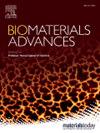Synergistic enhancement of desferrioxamine and strontium-doped hydroxyapatite via coaxial electrostatic spinning on osteogenic differentiation
IF 5.5
2区 医学
Q2 MATERIALS SCIENCE, BIOMATERIALS
Materials Science & Engineering C-Materials for Biological Applications
Pub Date : 2025-05-27
DOI:10.1016/j.bioadv.2025.214342
引用次数: 0
Abstract
Defective bone repair is a pressing issue in the field of bone regeneration due to donor shortages and the associated complications of bone grafting. Artificial bone repair materials offer more options and are attracting extensive attention from researchers. However, achieving efficient osteogenesis in clinical practice remains a challenge. Here, dual drug-releasing nanofibre membranes (NMs) for bone repair was fabricated by coaxial electrostatic spinning. Strontium-doped hydroxyapatite (SrHA) and desferrioxamine (DFO) were loaded into the shell and core of the NMs for slow and sustained release, respectively. Our results showed that the DFO/SrHA NMs significantly enhanced cell proliferation, angiogenesis and osteogenic differentiation of rat bone mesenchymal stem cells through the synergism of DFO and SrHA. This synergy results from the slow and sustained release of DFO and SrHA via NMs, which maintains the drug concentration in the effective range for a long time, ensuring long-term stable activation of the HIF-1 and Wnt/-catenin signalling pathways. Overall, the DFO/SrHA NMs provides a promising strategy for defective bone repair by enhancing osteogenic differentiation.
去铁胺和掺锶羟基磷灰石同轴静电纺丝对成骨分化的协同增强
由于供体短缺和骨移植的相关并发症,骨缺损修复是骨再生领域的一个紧迫问题。人工骨修复材料提供了更多的选择,引起了研究者的广泛关注。然而,在临床实践中实现有效的成骨仍然是一个挑战。本文采用同轴静电纺丝法制备了用于骨修复的双释药纳米纤维膜。将锶掺杂的羟基磷灰石(SrHA)和去铁胺(DFO)分别加载到纳米管的外壳和核中,缓释和缓释。我们的研究结果表明,DFO/SrHA NMs通过DFO和SrHA的协同作用,显著促进大鼠骨间充质干细胞的细胞增殖、血管生成和成骨分化。这种协同作用是由于DFO和SrHA通过NMs缓慢而持续地释放,使药物浓度长时间保持在有效范围内,从而确保HIF-1 α和Wnt/β-catenin信号通路的长期稳定激活。总之,DFO/SrHA NMs通过增强成骨分化为缺陷骨修复提供了一个有希望的策略。
本文章由计算机程序翻译,如有差异,请以英文原文为准。
求助全文
约1分钟内获得全文
求助全文
来源期刊
CiteScore
17.80
自引率
0.00%
发文量
501
审稿时长
27 days
期刊介绍:
Biomaterials Advances, previously known as Materials Science and Engineering: C-Materials for Biological Applications (P-ISSN: 0928-4931, E-ISSN: 1873-0191). Includes topics at the interface of the biomedical sciences and materials engineering. These topics include:
• Bioinspired and biomimetic materials for medical applications
• Materials of biological origin for medical applications
• Materials for "active" medical applications
• Self-assembling and self-healing materials for medical applications
• "Smart" (i.e., stimulus-response) materials for medical applications
• Ceramic, metallic, polymeric, and composite materials for medical applications
• Materials for in vivo sensing
• Materials for in vivo imaging
• Materials for delivery of pharmacologic agents and vaccines
• Novel approaches for characterizing and modeling materials for medical applications
Manuscripts on biological topics without a materials science component, or manuscripts on materials science without biological applications, will not be considered for publication in Materials Science and Engineering C. New submissions are first assessed for language, scope and originality (plagiarism check) and can be desk rejected before review if they need English language improvements, are out of scope or present excessive duplication with published sources.
Biomaterials Advances sits within Elsevier''s biomaterials science portfolio alongside Biomaterials, Materials Today Bio and Biomaterials and Biosystems. As part of the broader Materials Today family, Biomaterials Advances offers authors rigorous peer review, rapid decisions, and high visibility. We look forward to receiving your submissions!

 求助内容:
求助内容: 应助结果提醒方式:
应助结果提醒方式:


